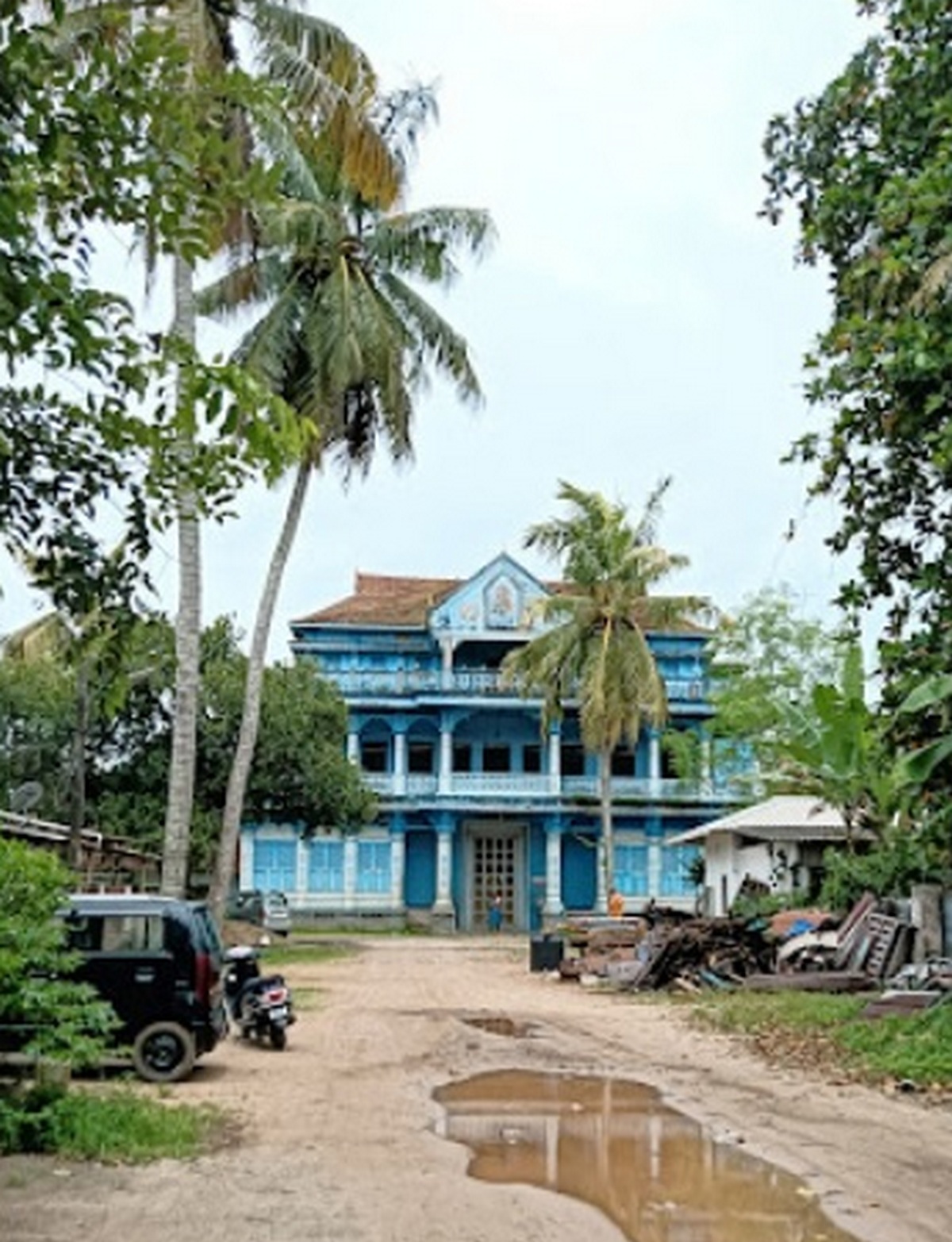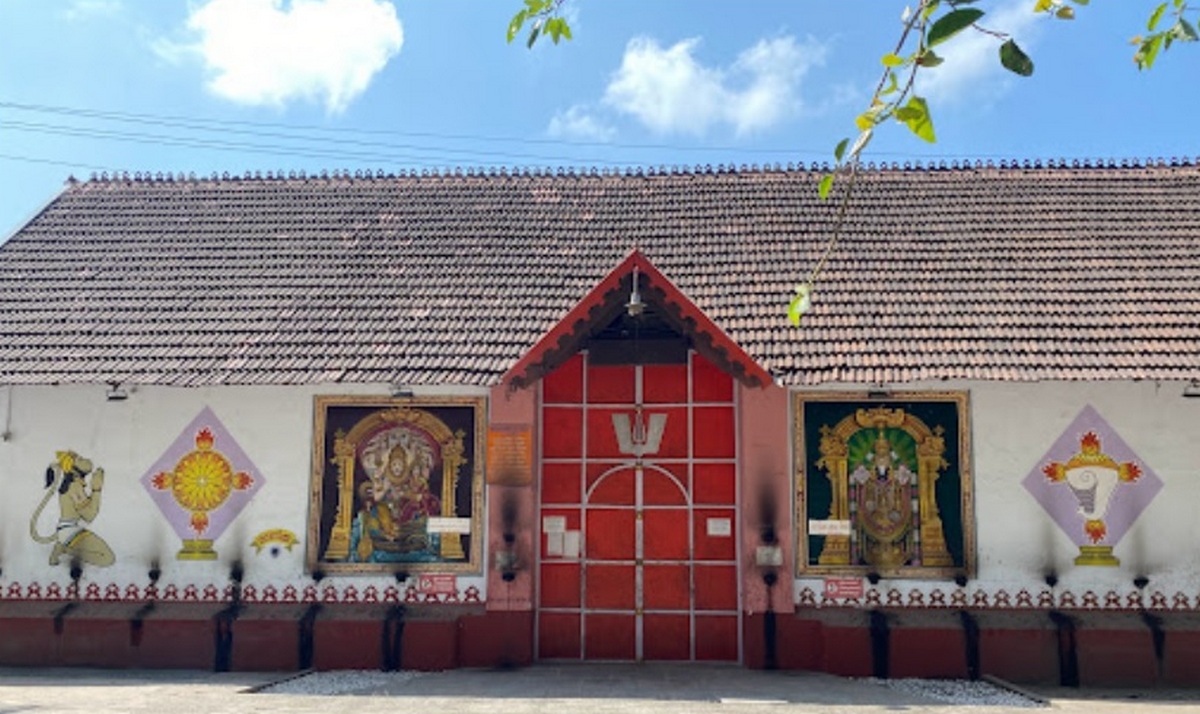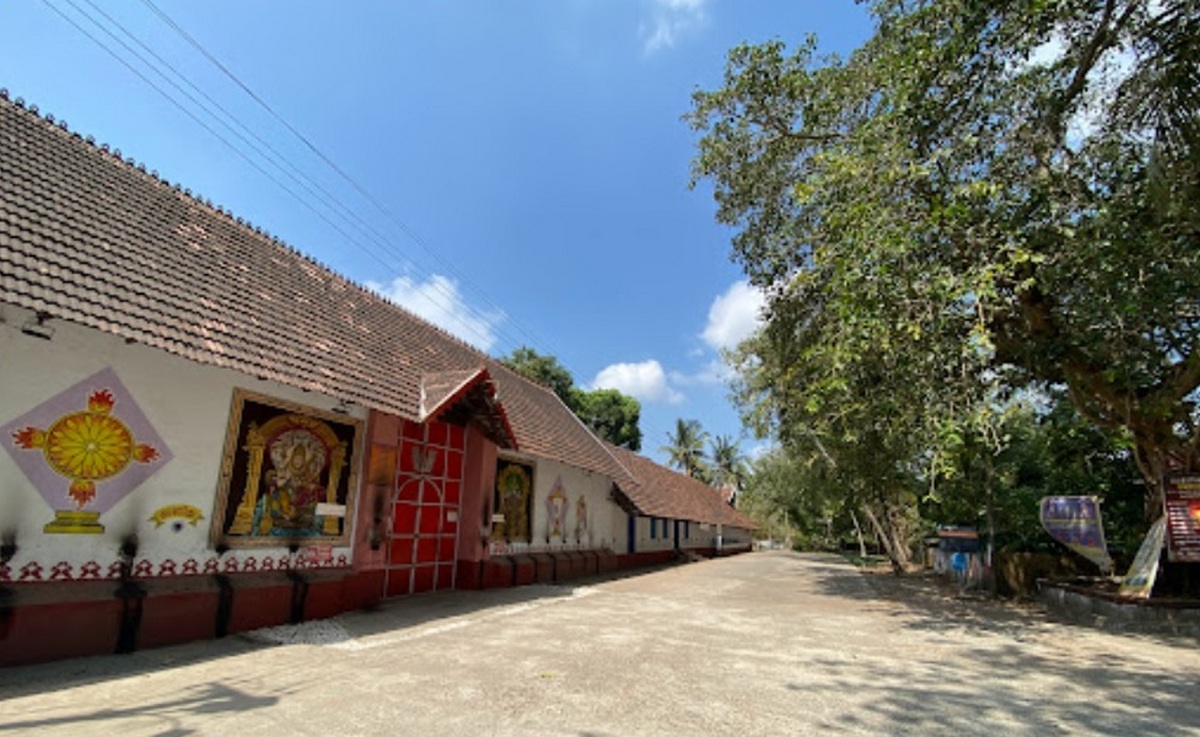Ananthanarayanapuram Temple is located at A.N Puram, in proximity to the Alleppey General Hospital, approximately 500 meters from the highway. It is commonly referred to as the New Thirumala Temple.

The principal deity is Sree Lakshmi Narasimha Murthy. The simhasana within the srikovil features Venkatachalapathy accompanied by Lakshmi Devi and Bhoomi Devi at the highest tier. Below this, Sree Narasimha Murthy is depicted with Mahalakshmi seated on his left lap. The Utsav deities are positioned on the subsequent tier.
In contrast to other GSB temples, the idols of Hanuman, Garuda, and Ganapati are collectively placed on a platform inside the srikovil. This temple is primarily recognized in connection with the case of the Cochin Venkatachalapathy idol. During the period of Portuguese persecution in Cochin, the rare Venkateswara idol, along with the idols of Lakshmi Devi from the Cochin Gosripuram temple and Narasimha Moorthi from the Thuravoor temple, was relocated to Alleppey in 1792 AD. These idols were housed in the North Agrasala of the Alleppey Venkatachalapathy (old Thirumala) temple for over sixty years. The presence of this sacred idol contributed to the growth of trade and commerce in Alleppey, establishing it as a significant seaport.
In the meantime, with a change in governance in Cochin, the new Raja recognized the idol's significance and requested its return. The idols of Venkatachalapathy, Lakshmi Devi, and Narasimha Murthi were relocated from the Agrasala of the old temple and consecrated in the new temple in 1852 AD by Srimad Bhuvanendra Tirtha Swamiji of Kashi Mutt. However, merely ten months after the consecration, the Venkatachalapathy idol was secretly transported back to Cochin during the night of February 7, 1853. It was discreetly removed from the Alleppey Ananthanarayana Puram Temple, concealed in a basket covered with Naivedyam (Mooleeku), and then transported to Cochin by a country boat, passing through Aroor and into the Cochin State.
The residents of Alleppey only became aware of this event the following morning, by which time the idol had already crossed the boundary of the Travancore State, leaving them unable to intervene. The original idols of Lakshmi Devi and Narasimha Murthi remain at the temple. In 1903 AD, a new idol of Venkatachalapathy was installed in this temple by Srimad Varadendra Tirtha. Initially, the temple hosted two annual festivals, each lasting eight days, in honor of Venkatachalapathy. According to the Devaprasnam, an additional five-day festival, Sree Narasimha Jayanthi, was introduced in 1913 AD to celebrate Narasimha Murthi. The vision, or Drishti, of the Narasimha Murthi is thought to be destructive. This is evidenced by the vacant space in front of the temple, where no structures are present.
To mitigate this effect, the position of the murthi has been adjusted to tilt backwards, thereby preventing the Drishti from directly impacting the area in front. A royal dignitary once visited the temple late in the evening, just as the sreekovil was being closed. The Poojari, having exhausted the flowers intended for the devotees, discreetly retrieved some flowers he had previously placed on his head and presented them to the visitor. The dignitary accepted the offering but, upon discovering a hair among the flowers, inquired whether the Narasimha Murthi had hair. Fearing the potential anger of the royal visitor, the Poojari affirmed that it did. The dignitary then demanded to see the hair of the Narasimha Murthi.
The Poojari explained that, as the poojas had concluded and the sreekovil was closed, he could only show the hair the following day. The visitor departed, insisting he would return the next day to view the hair. Meanwhile, the anxious Poojari spent the night in prayer to Lord Narasimha. A divine figure appeared in a dream to the Poojari, reassuring him not to be concerned and instructing him to advise the Visitor to observe the idol with one eye while keeping the other eye closed. The following day, as per the Poojari's guidance, the Visitor gazed at the idol with one eye, witnessing a radiant divine light; however, he subsequently lost the sight in that eye permanently.
അനന്തനാരായണ ക്ഷേത്രം ആലപ്പുഴ
ആലപ്പുഴ നഗരത്തിലെ ജനറൽ ആശുപത്രിക്ക് സമീപമുള്ള പഴയ തിരുമല ക്ഷേത്രത്തിൽ നിന്ന് ഏകദേശം ഒരു കിലോമീറ്റർ തെക്ക് മാറിയുള്ള പുതിയ സ്ഥലമായ 'അനന്തനാരായണപുര'യിൽ ഈ ക്ഷേത്രം സ്ഥിതി ചെയ്യുന്നു. 'അഖണ്ഡനാരായണപുരം' എന്ന പേരിൽ അറിയപ്പെട്ടിരുന്ന ഈ ക്ഷേത്രം കാലക്രമേണ അനന്തനാരായണപുരമായി മാറിയിട്ടുണ്ട്. 1852 AD-ൽ സ്ഥാപിതമായ പുതിയ തിരുമല ക്ഷേത്രം ആലപ്പുഴ അനന്തനാരായണപുരം ക്ഷേത്രം മറ്റുക്ഷേത്രങ്ങളെ അപേക്ഷിച്ച് പ്രൗഢഗംഭീരവും മനോഹരവുമായതാണ്. പ്രധാന പ്രതിഷ്ഠ ശ്രീ ലക്ഷ്മി നരസിംഹമൂർത്തിയാണ്. ശ്രീകോവിലിലെ സിംഹാസനത്തിൽ ലക്ഷ്മി ദേവിയോടും ഭൂമി ദേവിയോടും കൂടിയ വെങ്കിടാചലപതിയുണ്ട്.
അടുത്ത പടിയിൽ ഇടത് മടിയിൽ മഹാലക്ഷ്മി സഹിതമുള്ള ശ്രീ നരസിംഹമൂർത്തി സ്ഥിതിചെയ്യുന്നു. ഉത്സവ ദേവതകൾ അടുത്ത ഘട്ടത്തിലാണ്. മറ്റ് ഗൗഡ സരസ്വാത ബ്രാഹ്മണ ക്ഷേത്രങ്ങളിൽ നിന്ന് ഇത് വ്യത്യസ്തമാണ്. കൊച്ചി വെങ്കിടാചലപതി വിഗ്രഹവുമായി ബന്ധപ്പെട്ട ഈ ക്ഷേത്രം ഏറെ പ്രശസ്തമാണ്. കൊച്ചിയിലെ പോർച്ചുഗീസ് അധിനിവേശകാലത്ത്, കൊച്ചിൻ ഗോശ്രീപുരം ക്ഷേത്രത്തിലെ ലക്ഷ്മി ദേവിയുടെയും തുറവൂർ ക്ഷേത്രത്തിലെ നരസിംഹമൂർത്തിയുടെയും വിഗ്രഹങ്ങളോടൊപ്പം അപൂർവമായ വെങ്കിടേശ്വര വിഗ്രഹം 1792-ൽ ആലപ്പുഴയിലേക്ക് മാറ്റി. ആലപ്പി വെങ്കിടാചലപതി (പഴയ തിരുമല) ക്ഷേത്രത്തിന്റെ വടക്കേ അഗ്രശാലയിൽ 60 വർഷത്തിലേറെ സൂക്ഷിച്ചിരിക്കുന്നു.
ഈ ദൈവിക വിഗ്രഹത്തിന്റെ സാന്നിധ്യം ആലപ്പുഴയുടെ വ്യാപാര-വാണിജ്യ രംഗങ്ങളിൽ പുരോഗതി കൈവരിക്കാനും, ഒരു പ്രധാന കടൽ തുറമുഖമായി മാറാനും സഹായിച്ചു. കൊച്ചിയിലെ ഭരണമാറ്റത്തിനിടെ, കൊച്ചിയിലെ പുതിയ രാജാവ് വിഗ്രഹത്തിന്റെ പ്രാധാന്യം തിരിച്ചറിഞ്ഞു, അതിനെ തിരികെ ആവശ്യപ്പെട്ടു. എന്നിരുന്നാലും, വിഗ്രഹത്തിന്റെ സാന്നിധ്യം കാരണം ആലപ്പുഴയുടെ പുരോഗതി തടസ്സപ്പെടുകയും തിരുവിതാംകൂർ മഹാരാജാവ് അഭ്യർത്ഥന നിരസിക്കുകയും വെങ്കിടാചലപതി വിഗ്രഹത്തിന്റെ സുരക്ഷയും സംരക്ഷണവും ഉറപ്പാക്കുന്നതിനുള്ള നടപടികൾ സ്വീകരിക്കുകയും ചെയ്തു. പുതിയ ക്ഷേത്രത്തിൽ ഈ വിഗ്രഹം സ്ഥാപിക്കണമെന്ന് ദിവാൻ കൃഷ്ണ റാവുവിന് സ്ഥലം കൈമാറാനും പുതിയ ക്ഷേത്രം നിർമ്മിക്കാൻ ആവശ്യമായ ധനം നൽകാനും അദ്ദേഹം ആഗ്രഹിച്ചു.
അതനുസരിച്ച്, പഴയ തിരുമല ക്ഷേത്രത്തിന് ഏകദേശം ഒരു കിലോമീറ്റർ തെക്ക് പുതിയ സ്ഥലത്ത് ക്ഷേത്രം നിർമ്മിക്കപ്പെട്ടു. ഈ പുതിയ ക്ഷേത്രപരിസരത്തിന് മഹാരാജാവ് അനന്തനാരായണപുരം എന്ന പേരും നൽകി. അഖണ്ഡ നാരായണപുരം എന്നായിരുന്നു ഇതിന്റെ യഥാർത്ഥ പേര്, പിന്നീട് കാലക്രമേണ അനന്തനാരായണപുരമായി മാറി. തിരുവിതാംകൂർ മഹാരാജാവ് നിർദ്ദേശിച്ച പേര് അനന്തപത്മനാഭന്റെ തിരുവനന്തപുരത്തെ രാജകീയമായതാണ്. ലക്ഷ്മി ദേവിയുടെയും നരസിംഹമൂർത്തിയുടെയും യഥാർത്ഥ വിഗ്രഹങ്ങൾ ഇപ്പോഴും ക്ഷേത്രത്തിൽ നിലനിൽക്കുന്നു. 1903-ൽ ശ്രീമദ് വരദേന്ദ്ര തീർത്ഥൻ ഈ ക്ഷേത്രത്തിൽ വെങ്കിടാചലപതിയുടെ പുതിയ വിഗ്രഹം സ്ഥാപിച്ചു.
വെങ്കിടാചലപതിക്ക് 8 ദിവസത്തെ രണ്ട് വാർഷിക ഉത്സവങ്ങൾ ക്ഷേത്രം ആദ്യം ആഘോഷിച്ചു. ദേവപ്രശ്നത്തിൽ കാണുന്നതുപോലെ, നരസിംഹമൂർത്തിക്കായി 1913-ൽ മറ്റൊരു 5 ദിവസത്തെ വാർഷിക ഉത്സവം (ശ്രീ നരസിംഹ ജയന്തി) ആരംഭിച്ചു. ക്ഷേത്രത്തിലെ നരസിംഹജയന്തി ഉത്സവം ഒരു സംഭവത്തെ തുടർന്നാണ് ആരംഭിച്ചതെന്ന് പറയപ്പെടുന്നു. വാർഷിക ഉത്സവ സമയത്ത്, കമ്മ്യൂണിറ്റി അംഗങ്ങൾക്ക് ദിവസേന ഭക്ഷണം നൽകുന്ന രീതിയായിരുന്നു. ഒരു ദിവസം, സദ്യയുടെ അവസാനം പായസം വിതരണം ചെയ്തു, എല്ലാവരും അത് കഴിച്ചു. ഈ സമയത്ത്, പായസം അടങ്ങിയ പാത്രത്തിൽ പാകം ചെയ്ത വിഷപ്പാമ്പ് കണ്ടെത്തി. ഈ വാർത്ത കേട്ടപ്പോൾ, എല്ലാവരും ഭയന്നുപോയി, അധികാരികൾ എല്ലാവരോടും ക്ഷേത്രത്തിൽ തന്നെ തുടരാൻ അഭ്യർത്ഥിക്കുകയും നരസിംഹ ഭഗവാനെ ആരാധിക്കാൻ പ്രേരിപ്പിക്കുകയും ചെയ്തു.
അധികാരികളുടെ അഭ്യർത്ഥന അവഗണിച്ച് ക്ഷേത്രം വിട്ട ഒരാൾ ഒഴികെ, എല്ലാവരും പരിക്കേൽക്കാതെ രക്ഷപ്പെട്ടു. വിഷം കഴിച്ചാണ് ആ വ്യക്തി മരിച്ചത്. ഈ സംഭവത്തിനുശേഷം, നരസിംഹമൂർത്തിയുടെ കാലിന്റെ ഒരു വിരലിന്റെ അറ്റം, മൂർത്തി വിഷം വലിച്ചെടുക്കുന്നതുപോലെ നീലകലർന്നതായി പറയപ്പെടുന്നു. ദേവപ്രശ്നത്തിൽ.ദേവപ്രശ്നത്തിൽ കാണുന്നതുപോലെ നരസിംഹജയന്തി ഉത്സവം പിന്നീട് ആരംഭിച്ചു. നരസിംഹമൂർത്തിയുടെ ദർശനം അല്ലെങ്കിൽ ദൃഷ്ടി വിനാശകരമാണെന്ന് വിശ്വസിക്കപ്പെടുന്നു. ഇത് സൂചിപ്പിക്കുന്നത് ക്ഷേത്രത്തിന് മുന്നിലെ ആളൊഴിഞ്ഞ പ്രദേശമാണ്, ഇവിടെ ഒരു സ്ഥാപനവും നിലവിലില്ല. ഇത് ഒഴിവാക്കാൻ, ദൃഷ്ടി നേരിട്ട് മുൻവശത്ത് വീഴാതിരിക്കാൻ മൂർത്തിയുടെ പ്രതിഷ്ഠ പിന്നിലേക്ക് ചരിഞ്ഞു. ഒരു കാലത്ത് ഒരു രാജകീയ സന്ദർശകൻ വൈകുന്നേരം ശ്രീകോവിൽ എത്തി. ക്ഷേത്രം അടച്ചിരിക്കുമ്പോൾ, പൂജാരി ഭക്തർക്ക് നൽകുന്ന പൂക്കൾ തീർന്നതിനാൽ, അദ്ദേഹം തന്റെ തലയിൽ സൂക്ഷിച്ചിരുന്ന കുറച്ച് പൂക്കൾ (സന്ദർശകന്റെ ശ്രദ്ധയിൽപ്പെടാതെ) പുറത്തെടുത്ത് അവൻക്ക് സമർപ്പിച്ചു.
സന്ദർശകൻ അത് സ്വീകരിച്ചപ്പോൾ, പൂക്കളിൽ മുടി കാണുമ്പോൾ, നരസിംഹമൂർത്തിക്ക് മുടിയുണ്ടോ എന്ന് അദ്ദേഹം ചോദിച്ചു. രാജകോപം ഭയന്ന്, പൂജാരി അതെ എന്ന് മറുപടി നൽകി. തുടർന്ന്, നരസിംഹമൂർത്തിയുടെ മുടി കാണിക്കണമെന്ന് സന്ദർശകൻ ആവശ്യപ്പെട്ടു. പൂജ കഴിഞ്ഞതിനാൽ, ശ്രീകോവിൽ അടച്ചിരിക്കുന്നതിനാൽ, അടുത്ത ദിവസം മാത്രമേ മുടി കാണിക്കാൻ കഴിയൂ എന്ന് പൂജാരി പറഞ്ഞു. സന്ദർശകൻ മുടി കാണാൻ അടുത്ത ദിവസം വരുമെന്ന് ഉറപ്പിച്ച് ക്ഷേത്രം വിട്ടു. ആശങ്കിതനായ പൂജാരി രാത്രി മുഴുവൻ നരസിംഹ ഭഗവാനെ പ്രാർത്ഥിച്ചു. ഭഗവാൻ സ്വപ്നത്തിൽ പ്രത്യക്ഷപ്പെട്ട് പൂജാരിയോട് വിഷമിക്കേണ്ടതില്ലെന്ന് പറഞ്ഞു. കൂടാതെ, മറ്റൊരു കണ്ണ് അടച്ച് ഒരു കണ്ണിലൂടെ മാത്രമേ വിഗ്രഹം കാണാൻ സന്ദർശകനോട് ആവശ്യപ്പെടുകയുള്ളൂ എന്നും നിർദ്ദേശിച്ചു.
അടുത്ത ദിവസം, പൂജാരി ആവശ്യപ്പെട്ടതനുസരിച്ച്, സന്ദർശകൻ ഒറ്റക്കണ്ണിലൂടെ വിഗ്രഹം കാണുകയും, അതിൽ ദിവ്യമായ പ്രകാശം അനുഭവിക്കുകയും, ആ കണ്ണിന്റെ കാഴ്ച ശാശ്വതമായി നഷ്ടമായതായി പറയപ്പെടുന്നു. ക്ഷേത്രത്തിന്റെ ചുവരുകളിൽ ചിത്രീകരിച്ചിരിക്കുന്ന അതിമനോഹരമായ രാമായണ ചിത്രങ്ങൾ, മറ്റ് ക്ഷേത്രങ്ങളിൽ നിന്ന് ഈ ക്ഷേത്രത്തെ വ്യത്യസ്തമാക്കുന്നു. 166 വർഷം പഴക്കമുള്ള ഈ ചുവർചിത്രങ്ങളിൽ പ്രധാനമായും രാമായണത്തിലെ സംഭവങ്ങൾ പ്രതിഫലിപ്പിച്ചിരിക്കുന്നു. ഇവയുടെ അടിക്കുറിപ്പിൽ ചതുരലിപിയിൽ കഥാസാരവും ഉൾപ്പെടുത്തിയിട്ടുണ്ട്. കാലാവസ്ഥയുടെ ബാധയും പഴക്കവും മൂലമുണ്ടായ നാശങ്ങൾ ഇവയ്ക്ക് സംഭവിക്കുകയാണ്.



